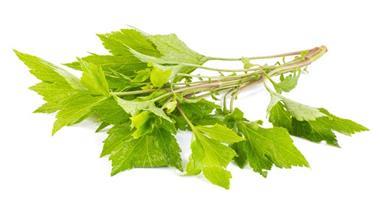Mugwort: A Weed to Some, but a Beneficial Herb to Others

Story at-a-glance
- Weeds are considered a gardening nuisance because they can spread like wildfire. But one weed in particular may help you change your mind about them: mugwort
- Despite being classified as a weed, mugwort surprisingly has several practical applications, many of which you may find useful
Weeds are invasive plant species that can thrive in various environments.1 They typically produce a large number of seeds, which allows them to take over a location where they are not supposed to grow. Hence, gardeners exert tremendous effort to remove them whenever possible because their produce can suffer.2
However, not all weeds are inherently bad — some can actually be beneficial to your health, like mugwort.
Mugwort (Artemisia vulgaris) is an aromatic plant with a rich history, with many ancient cultures having numerous uses for it. Its botanical name is derived from Artemis, the Greek goddess for chastity, virginity, the hunt and the environment.3
Historically, Anglo-Saxon tribes revered mugwort as a sacred herb gifted to them by their chief deity, Woden. Romans, on the other hand, planted mugwort on sidewalks to help travelers rest their feet from long walks.4
The Benefits of Mugwort
Mugwort plays an important role in Chinese acupuncture, with a history going back around 3,000 years.5 It is used in moxibustion, a process where mugwort leaves are gathered into sticks or cones the size of a cigar, and then burned over an acupuncture point to help release energy.6
Moxibustion can help treat menstrual cramping, stimulate a regular menstrual cycle and may even aid unborn infants to move into the correct position prior to delivery. In a study published in the Cochrane Database of Systematic Reviews, researchers noticed that performing moxibustion at the tip of the fifth toe yielded positive results for infants in the breech position.7
Native American tribes in California also use mugwort in their folk medicine tradition. It is believed to help with common conditions such as pain, colds and allergies.8
Different Uses of Mugwort You May Like
Despite being classified as a weed, mugwort surprisingly has several practical applications, which you may find useful. The most well-known include:9
• Cooking ingredient — Mugwort leaves are known for their bitter flavor. You can use them for flavoring meat or fish, or even add them to a green smoothie.
• Dream pillow — This is a small pillow filled with one or more aromatic herbs, which can help provide a relaxing sleep. Mugwort is a popular choice for this particular product.10
• Natural insecticide — Mugwort’s aroma is useful in helping keep pests out of your garden. If you plan to try this method, keep mugwort in a pot because it can spread rapidly throughout your garden if planted on soil.
• Incense — Create a mugwort incense to help kill bad bacteria and spread a wonderful aroma around your home.
Growing Mugwort in Your Garden
Being a weed, mugwort can thrive just about anywhere, from fields to ditches and even the side of the road.11 That being said, growing mugwort requires discipline and consistency, because it can quickly overtake your garden and become truly invasive. Here are some tips to help you out:
• Preparing mugwort seeds — Before growing mugwort, the seeds need to be prepared for germination through stratification, a method that breaks seed dormancy by creating an optimal environment for them to grow. This drastically reduces the time it takes for seedlings to emerge.12
To stratify the seeds, you must simulate a cold climate. Start by mixing them with lightly misted sandy soil or peat moss inside a plastic bag. Then, chill the bag in a refrigerator for two weeks. Check every other day to ensure that the mixture is moist. If not, add some water again to maintain moisture.13
• Planting the seeds in your garden — Once stratification is done, plant the seeds during the early spring, because the cold soil will enhance the stratified seeds further. Scatter the seeds lightly and evenly on the soil’s surface, 3 inches apart in all directions.14
Don’t worry about the soil’s pH level. However, it should have good drainage and full sun exposure. If all instructions are followed correctly, seedlings should appear in two weeks.15
• What to do once seedlings emerge — Once the seedlings reach a height of 4 inches, prune them to avoid overcrowding. Spread out the healthy seedlings, placing them 2 feet apart. Low-quality seedlings can be removed using garden shears.16
• Maintaining your mugwort plants — As your plants grow and reach maturity, maintain them properly to yield a high-quality harvest. Avoid overwatering, and trim them to prevent being overshadowed by fellow mugwort plants. If a plant becomes too heavy to support itself, remove the top or sides with pruning shears.17
Recipe: Making Mugwort Tea
Mugwort has several applications in cooking, but it is mostly known as an alternative to tea. It became popular during World War II in England, due to the increasing prices of regular tea throughout that period.18
How to Harvest the Best Mugwort Tea Leaves
Directions
Harvesting mugwort specifically for tea follows a certain procedure. Please follow this to harvest high-quality mugwort tea:
- Cut the top one-third of the plant when mugwort’s flower is in bloom.
- Hang the plant upside down to dry (such as from an indoor clothesline), or chop it into small pieces, and spread out on a newspaper. The roots are dug up and collected in the fall.
- Use a scrub brush and running water to clean the roots, then spread them out on a newspaper to let them dry completely.
- Store all parts of the plant away from light, such as in paper bags.
How to Make Mugwort Tea
Procedure
- Place 1 ounce of dried mugwort in 4 cups of boiling water and let it boil for five to 10 minutes, then strain.
- If you let it sit longer and make a standard infusion in a Mason jar for four hours, the tea will become quite bitter.
- Feel free to halve this recipe if you want to make less tea. You can keep any unused tea in the refrigerator for two to three days.
You Can Make Mugwort Root Tea as Well
Procedure
For a different kind of tea flavor, you can use mugwort roots. Here’s the procedure:
- Chop 1 ounce of mugwort roots and place them inside a glass or ceramic pot. Add 4 cups water afterward.
- Let the mixture come to a boil, then continue to simmer while covered, until it reduces by half. This should take around 20 to 30 minutes.
- Strain and drink.
Mugwort Is Also Useful as an Essential Oil
Aside from its culinary uses, mugwort enjoys a reputation in aromatherapy, which is the practice of using, dispersing or applying essential oils to promote better health. “Essential Oils: All-Natural Remedies and Recipes for Your Mind, Body and Home” discusses various ways mugwort oil can benefit you to:19
• Relieve pain — The essential oil may help ease inflammation such as arthritis and stiff muscles.
• Fight colds — Mugwort essential may help decongest and loosen up phlegm to provide relief in your respiratory system.
• Support women’s health — Gently massaging the oil on the abdomen may help ease cramps and tension.
• Boost mood — The aroma of mugwort can uplift and relax your mood.
Before using mugwort essential oil, be sure to visit a doctor to make sure mugwort is an herb that will be beneficial for you. Your skin may have an allergic reaction to it, making it unsafe to use. You can perform a skin patch test by placing a diluted drop on your arm; wait and see if any negative reactions occur. If you’re pregnant, it’s best not to use this oil to avoid any side effects.
Sources and References
- 1 USDA National Invasive Species Information Center, “Invasive Species: Plants”
- 2 Department of the Environment and Energy, “What Is a Weed?”
- 3 GreekMythology.com, “Artemis”
- 4 Encyclopedia.com, “Mugwort”
- 5 The Epoch Times, January 4, 2015
- 6 University of Minnesota, “Moxibustion”
- 7 The Cochrane Database of Systematic Reviews, “Cephalic Version by Moxibustion for Breech Presentation” May 16, 2012
- 8 Journal of Herbal Medicine, 2013 June 1;3(2):47-51
- 9, 18 The Grow Network, “For the Love of Mugwort: 7 Uses for Mugwort” October 5, 2015
- 10 Adventures in Making, “DIY: Dream Pillows”
- 11 Gardening Know How, “Mugwort Control: Tips for Getting Rid of Mugwort”
- 12 Gardening Know How, “Seed Stratification: Learn About Stratification of Seeds & What Seeds Require Cold Treatment”
- 13, 14, 15, 16, 17 The Bump, “How to Grow Mugwort and Germination Instructions”
- 19 Essential Oils: All-Natural Remedies and Recipes for Your Mind, Body and Home

